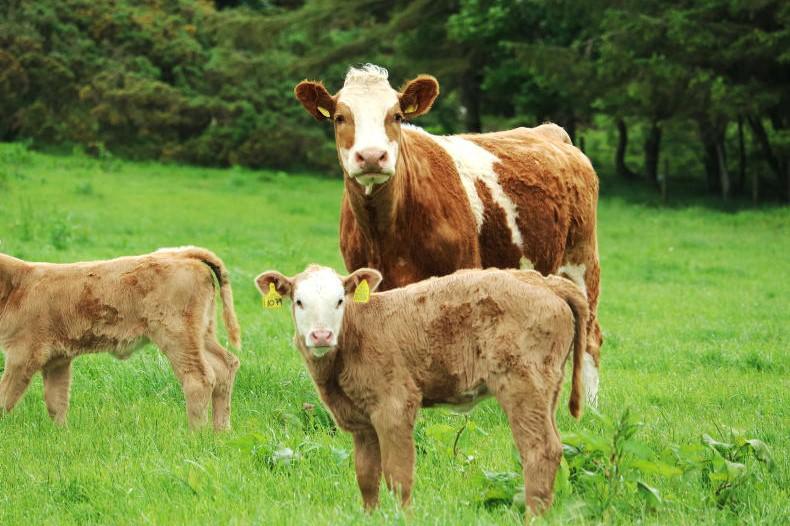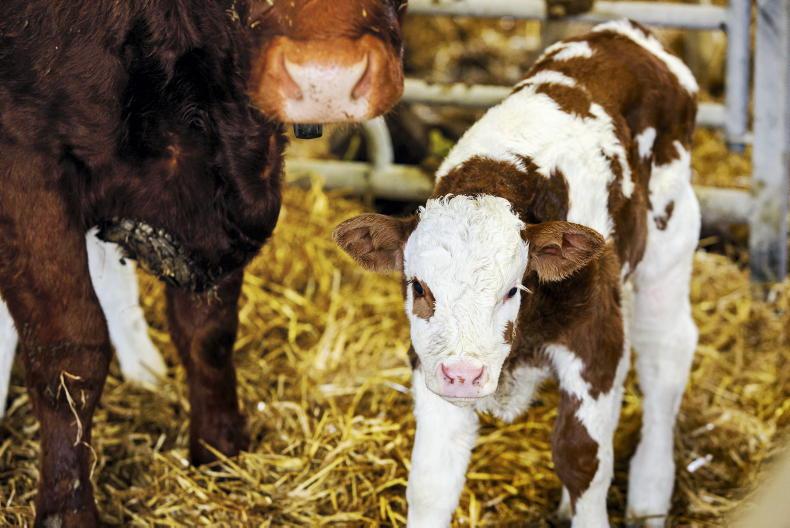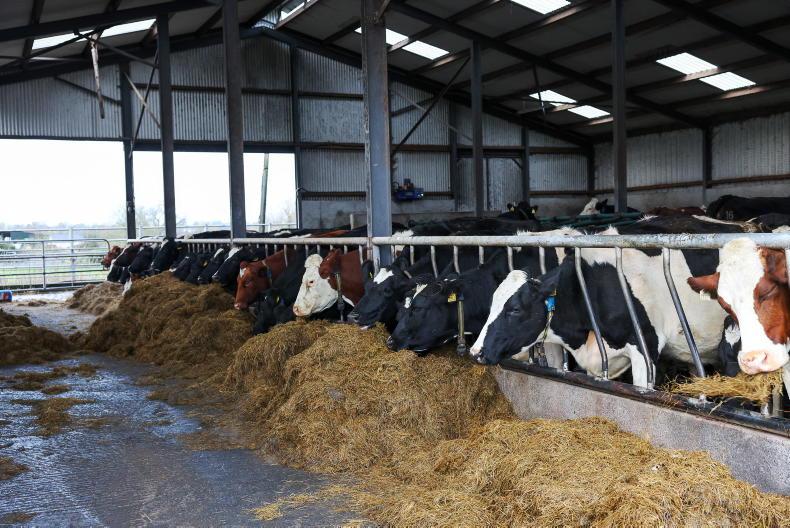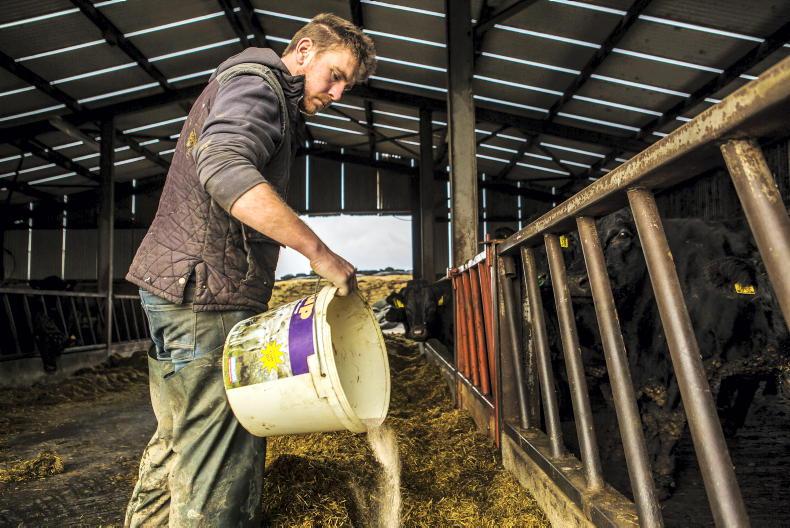August usually sees autumn calving getting under way on suckler farms and a well-managed herd should encounter fewer problems.
When it comes to managing autumn cows, there are different factors to consider compared with spring calving.
Outlined are five things to consider when managing autumn-calving herds.
Always think about safety
Working with freshly-calved suckler cows always has an element of risk. However, as autumn herds tend to calve outside more, the element of danger increases.
A cow can be one of the quietest animals in the herd for 51 weeks of the year. But at the time of calving and for a few days afterwards, the cow’s protective instinct can make her extremely aggressive and unpredictable.
Therefore, always keep safety in mind when dealing with autumn cows. Keep children and farm dogs well away from freshly-calved cows.
Autumn cows will naturally be fit and the vast majority will calve on their own. But there will be occasions when a problem arises.
Make sure you have an escape route before entering a paddock, or calving pen, to intervene during labour or to resuscitate a calf.
On the occasions when it is necessary to help a newborn calf, having a second person at hand is recommended. Never ever turn your back on the cow.
If the calf needs to be stomach tubed, then always bring animals into a secure handling pen. Keeping the calf at the cow’s head can help settle the animal, as can offering some concentrate.
Tagging calves
When it comes to tagging calves that are born outside, it is best to run cows into a shed or handling pen, so newborn animals can be safely tagged.
Leaving this task for a weekend, when more family help may be available, can be more practical and safer to carry out.
Housing in-calf cows overnight
Allowing in-calf cows out to grass during the day, then rehousing at night is recommended if the yard is set up correctly.
Nights are closing in, so by housing cows in the evening, it will be much easier to intervene when necessary if a cow gets into difficulty at night.
It is also a good time to assess cows, noting the physical changes in the udder and pin bones as animals get closer to calving.
Housing in the evening also provides a safer environment for separating out cows that calved during the day. Calves can then be tagged and any wet navels treated.
Dealing with mastitis
Cows that had problems with summer mastitis should be housed after calving. Affected quarters will need to be milked out regularly to reduce the pain and inflammation.
Their calves tend to be weak and often require greater assistance in early life. Make sure these calves get as much colostrum as possible in the first six hours of life.
Cows will need affected quarters stripped out for a few days to a week after calving, as the pain will prevent them standing to let the calf to suck. An anti-inflammatory can help with pain relief along with antibiotics.
Make sure cows are properly secured in a headlock when stripping quarters and work with caution to avoid being kicked by the cow.
In some parts of the country, there is the option to sell the calf through the live ring and fatten the cow, and this should be considered where a cow has lost multiple quarters to mastitis.
Tetany prevention
Weather conditions can be more variable through August and into September, increasing the risk of grass tetany.
Grazing lush silage aftermath, or swards that recently received slurry, will also increase the risk of tetany.
Make sure freshly-calved cows are properly supplemented with magnesium to reduce this risk as autumn progresses.
Read more
Positive outlook for beef price
Strong grain markets push prices up at least €25/t
August usually sees autumn calving getting under way on suckler farms and a well-managed herd should encounter fewer problems.
When it comes to managing autumn cows, there are different factors to consider compared with spring calving.
Outlined are five things to consider when managing autumn-calving herds.
Always think about safety
Working with freshly-calved suckler cows always has an element of risk. However, as autumn herds tend to calve outside more, the element of danger increases.
A cow can be one of the quietest animals in the herd for 51 weeks of the year. But at the time of calving and for a few days afterwards, the cow’s protective instinct can make her extremely aggressive and unpredictable.
Therefore, always keep safety in mind when dealing with autumn cows. Keep children and farm dogs well away from freshly-calved cows.
Autumn cows will naturally be fit and the vast majority will calve on their own. But there will be occasions when a problem arises.
Make sure you have an escape route before entering a paddock, or calving pen, to intervene during labour or to resuscitate a calf.
On the occasions when it is necessary to help a newborn calf, having a second person at hand is recommended. Never ever turn your back on the cow.
If the calf needs to be stomach tubed, then always bring animals into a secure handling pen. Keeping the calf at the cow’s head can help settle the animal, as can offering some concentrate.
Tagging calves
When it comes to tagging calves that are born outside, it is best to run cows into a shed or handling pen, so newborn animals can be safely tagged.
Leaving this task for a weekend, when more family help may be available, can be more practical and safer to carry out.
Housing in-calf cows overnight
Allowing in-calf cows out to grass during the day, then rehousing at night is recommended if the yard is set up correctly.
Nights are closing in, so by housing cows in the evening, it will be much easier to intervene when necessary if a cow gets into difficulty at night.
It is also a good time to assess cows, noting the physical changes in the udder and pin bones as animals get closer to calving.
Housing in the evening also provides a safer environment for separating out cows that calved during the day. Calves can then be tagged and any wet navels treated.
Dealing with mastitis
Cows that had problems with summer mastitis should be housed after calving. Affected quarters will need to be milked out regularly to reduce the pain and inflammation.
Their calves tend to be weak and often require greater assistance in early life. Make sure these calves get as much colostrum as possible in the first six hours of life.
Cows will need affected quarters stripped out for a few days to a week after calving, as the pain will prevent them standing to let the calf to suck. An anti-inflammatory can help with pain relief along with antibiotics.
Make sure cows are properly secured in a headlock when stripping quarters and work with caution to avoid being kicked by the cow.
In some parts of the country, there is the option to sell the calf through the live ring and fatten the cow, and this should be considered where a cow has lost multiple quarters to mastitis.
Tetany prevention
Weather conditions can be more variable through August and into September, increasing the risk of grass tetany.
Grazing lush silage aftermath, or swards that recently received slurry, will also increase the risk of tetany.
Make sure freshly-calved cows are properly supplemented with magnesium to reduce this risk as autumn progresses.
Read more
Positive outlook for beef price
Strong grain markets push prices up at least €25/t









SHARING OPTIONS